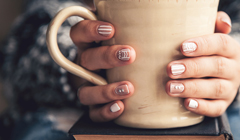- Sandra Beasley
- COUNTDOWN TO PUBLICATION: 41 Days
COUNTDOWN TO PUBLICATION: 41 Days

Contributor
My second poetry collection, I Was the Jukebox, won the 2009 Barnard Women Poets Prize (selected by Joy Harjo) and will be launched into the world on April 5, 2010 by W. W. Norton.
Hello all! Thanks so much for the welcoming response to my last "countdown" entry. I thought I'd switch gears and post on a practical topic. Specifically: let's say you snag an opportunity to promote a book of yours--whether through a reading, a print excerpt, or a guest-blog post. What are the basic publicity materials you need to have at the ready? What can you do, in other words, to help us help you?
I've often been on the other side of the equation--not as the author, but as the helper. I've worked on the staff of several magazines, served on the editorial board for a regional publishing house, and I currently volunteer as the host of a reading series at the Arts Club of Washington, here in DC. Some authors are really on the ball about providing the secondary materials I need to promote their work. Other authors...not so much.
Those in the second camp miss out, regardless of how great their writing may be. If every other poet in my literary journal has an author headshot next to their byline, and yours is missing (or blurry), your page looks low-rent. If a newspaper has a month-out deadline for their arts calendar, and and you sit on my request to proof the press release with the bio I had to cobble together from your website, your reading isn't going to get listed. It's just that simple.
Without further ado, three things every writer should have at the ready (complete with formatting suggestions):
AUTHOR PHOTO
I really enjoyed Randy Susan Meyers' recent post on "Photoshop-Botox for Author Photos." An additional thought, based on my days at a magazine where I was in charge of photo-editing: Be careful of poses that are difficult to crop. Bringing your knee or your hand up by your head may look really cute when we can see the full-body posture. But if I've got a box in layout big enough for only your face, a random knee floating by your left ear--or an index finger thoughtfully crossing your chin--is going to look mighty strange.
Every author photo is really four photos: the color version, the grayscale version, and for each of these, a "big" and "small" version--a print-ready file of 300 dpi, minimum 4x6 inches, as well as a web-friendly version at 72 dpi, minimum 2x3 inches. Why multiple file sizes? Traditional printing processes require a lot more "dots per inch" of ink in order to define an image, whereas our eye registers a picture on screen using much less data. Those who work online don't want to have to upload hefty files that clutter their server space; printers forced to run less than 300 dpi end up with grainy or blurred images. JPG is the current standard format (a few publications request TIF, but can usually deal with JPG in a pinch). BMPs from Paintbrush are not acceptable, nor are GIFs--it's a function of file size, compression, and palette management.
Name your file "[Last name][First name]" (i.e., "DoeJane") or, if a credit is needed, "[Last name][First initial]Credit[Photographer First name][Photographer last Name]" (i.e., "DoeJCreditMattBell"). I can't tell you how many author photos go to magazines having just been ripped from a digital camera--with the nondescript, overly long file name to boot. If a file like that gets saved to a folder, it's really tough to find again. And in the last-minute stages of proofing, it's really handy to have the author name (and photographer credit) embedded for reference.
 Intimidated by the process, but can't afford a studio portrait? Look through your regional media publications and see if there's a staff photographer whose work you consistently like. Contact them, explain that you're a local author, and see if they'll quote an estimate for a quick off-hours session. Since they aren't trying to make a living specifically from freelance work, these photographers can be more flexible in their rates. You might not get the most dramatic staging, but you WILL get professionally rendered files and a multitude of proofs to choose from. Be sure to pay a flat fee that covers all future usage; your publisher will expect as much.
I got incredibly lucky when W. W. Norton told me I needed an author photo ASAP. For years I had admired the work of Matthew Worden, chief photographer for Washingtonian, and he replied to my please-help-me! email with grace and a reasonable eye toward what a young writer could afford to pay. We met up at the National Cathedral--one of DC's few scenic outdoor sites NOT overseen by the Park Service, which requires fee-based licensing for all photo shoots. Matthew is truly an artist, not to mention a good sport; if the author photo works, it's because it is the record of a fun afternoon.
Intimidated by the process, but can't afford a studio portrait? Look through your regional media publications and see if there's a staff photographer whose work you consistently like. Contact them, explain that you're a local author, and see if they'll quote an estimate for a quick off-hours session. Since they aren't trying to make a living specifically from freelance work, these photographers can be more flexible in their rates. You might not get the most dramatic staging, but you WILL get professionally rendered files and a multitude of proofs to choose from. Be sure to pay a flat fee that covers all future usage; your publisher will expect as much.
I got incredibly lucky when W. W. Norton told me I needed an author photo ASAP. For years I had admired the work of Matthew Worden, chief photographer for Washingtonian, and he replied to my please-help-me! email with grace and a reasonable eye toward what a young writer could afford to pay. We met up at the National Cathedral--one of DC's few scenic outdoor sites NOT overseen by the Park Service, which requires fee-based licensing for all photo shoots. Matthew is truly an artist, not to mention a good sport; if the author photo works, it's because it is the record of a fun afternoon.
 COVER ART
Again, you should have both a web-ready and a print-quality version, in JPG format. If you ask your press to send a file, be sure it's not in "PSD" format; that's a big Photoshop file with multiple layers, used by designers still editing text. It shouldn't be difficult for them to merge and export on their end in a different format.
If for whatever reason you don't have a digital image, and you have to scan your book cover, be sure to do so at a high resolution. Minimize shadows (if the book's bulk prevents the scanner cover from closing properly) by tucking a clean white cloth over and around the book. Line up the text to be as straight as possible, and crop the result so that the edges of the physical book don't show. It's not ideal, but it'll work.
BIO
A bio should be written in the third person, and should begin with your full name. Avoid a possessive construction (i.e., use "JANE DOE is the author of..., not "JANE DOE'S book...." Why? A lot of magazines use special formatting for the author names in the layout of their Contributor Page or bylines, and having to deal with an apostrophe-S makes their job harder. Never make their job harder if you can avoid it.
You should have three different versions of your bio note: a 50-word cut (principle publications, career if relevant, place of residence); a 100-word cut (all that plus anthology pubs, recent honors, and/or institutional affiliations); and a 200-300 word narrative that provides a character sketch of family, volunteer work, etc., but would probably not be reproduced verbatim.
I confess, I also have a 75-word cut, and one designed to meet the weird 500-word character cap (including spaces) imposed by AWP when they call for event proposals. When one bio gets updated, they all get proofed.
Some people steer away from including prizes, fellowships, or colony stays in their bio notes, arguing that it's not interesting to the reader. Personally, I think of it as a hat tip to organizations that have supported me. Up to you. If you include a URL, make it clean: no need to include the "http://" or underline it per the days of yore.
It's a pet peeve of mine when people direct me to their website, or send a really unwieldy bio (500 words when I've asked for 50) and say "edit it however you like." One, what looks impressive to me may not be important to you, or may be an outdated accomplishment. Two, every time your bio gets edited, it's an opportunity for typos to be introduced--and I have seen some humdingers. (You've been recognized for your "pubic service"? Really?)
...
Admittedly, what I've given you is formulaic by design. There are always glorious exceptions to the rules: the fantastic headshot of someone looking out through splayed fingertips, or a bio note that concludes "Every July, she runs with the bulls in Pamplona." But make conscious decisions about how you shape your professional persona, whatever that persona may be. There's a lot of talented writers who are casual to a fault when it comes to these matters. If I'm taking the time--as a host, an editor, or a blogger--to honor your work, I want to see that you're honoring it, too.
COVER ART
Again, you should have both a web-ready and a print-quality version, in JPG format. If you ask your press to send a file, be sure it's not in "PSD" format; that's a big Photoshop file with multiple layers, used by designers still editing text. It shouldn't be difficult for them to merge and export on their end in a different format.
If for whatever reason you don't have a digital image, and you have to scan your book cover, be sure to do so at a high resolution. Minimize shadows (if the book's bulk prevents the scanner cover from closing properly) by tucking a clean white cloth over and around the book. Line up the text to be as straight as possible, and crop the result so that the edges of the physical book don't show. It's not ideal, but it'll work.
BIO
A bio should be written in the third person, and should begin with your full name. Avoid a possessive construction (i.e., use "JANE DOE is the author of..., not "JANE DOE'S book...." Why? A lot of magazines use special formatting for the author names in the layout of their Contributor Page or bylines, and having to deal with an apostrophe-S makes their job harder. Never make their job harder if you can avoid it.
You should have three different versions of your bio note: a 50-word cut (principle publications, career if relevant, place of residence); a 100-word cut (all that plus anthology pubs, recent honors, and/or institutional affiliations); and a 200-300 word narrative that provides a character sketch of family, volunteer work, etc., but would probably not be reproduced verbatim.
I confess, I also have a 75-word cut, and one designed to meet the weird 500-word character cap (including spaces) imposed by AWP when they call for event proposals. When one bio gets updated, they all get proofed.
Some people steer away from including prizes, fellowships, or colony stays in their bio notes, arguing that it's not interesting to the reader. Personally, I think of it as a hat tip to organizations that have supported me. Up to you. If you include a URL, make it clean: no need to include the "http://" or underline it per the days of yore.
It's a pet peeve of mine when people direct me to their website, or send a really unwieldy bio (500 words when I've asked for 50) and say "edit it however you like." One, what looks impressive to me may not be important to you, or may be an outdated accomplishment. Two, every time your bio gets edited, it's an opportunity for typos to be introduced--and I have seen some humdingers. (You've been recognized for your "pubic service"? Really?)
...
Admittedly, what I've given you is formulaic by design. There are always glorious exceptions to the rules: the fantastic headshot of someone looking out through splayed fingertips, or a bio note that concludes "Every July, she runs with the bulls in Pamplona." But make conscious decisions about how you shape your professional persona, whatever that persona may be. There's a lot of talented writers who are casual to a fault when it comes to these matters. If I'm taking the time--as a host, an editor, or a blogger--to honor your work, I want to see that you're honoring it, too.
 Intimidated by the process, but can't afford a studio portrait? Look through your regional media publications and see if there's a staff photographer whose work you consistently like. Contact them, explain that you're a local author, and see if they'll quote an estimate for a quick off-hours session. Since they aren't trying to make a living specifically from freelance work, these photographers can be more flexible in their rates. You might not get the most dramatic staging, but you WILL get professionally rendered files and a multitude of proofs to choose from. Be sure to pay a flat fee that covers all future usage; your publisher will expect as much.
I got incredibly lucky when W. W. Norton told me I needed an author photo ASAP. For years I had admired the work of Matthew Worden, chief photographer for Washingtonian, and he replied to my please-help-me! email with grace and a reasonable eye toward what a young writer could afford to pay. We met up at the National Cathedral--one of DC's few scenic outdoor sites NOT overseen by the Park Service, which requires fee-based licensing for all photo shoots. Matthew is truly an artist, not to mention a good sport; if the author photo works, it's because it is the record of a fun afternoon.
Intimidated by the process, but can't afford a studio portrait? Look through your regional media publications and see if there's a staff photographer whose work you consistently like. Contact them, explain that you're a local author, and see if they'll quote an estimate for a quick off-hours session. Since they aren't trying to make a living specifically from freelance work, these photographers can be more flexible in their rates. You might not get the most dramatic staging, but you WILL get professionally rendered files and a multitude of proofs to choose from. Be sure to pay a flat fee that covers all future usage; your publisher will expect as much.
I got incredibly lucky when W. W. Norton told me I needed an author photo ASAP. For years I had admired the work of Matthew Worden, chief photographer for Washingtonian, and he replied to my please-help-me! email with grace and a reasonable eye toward what a young writer could afford to pay. We met up at the National Cathedral--one of DC's few scenic outdoor sites NOT overseen by the Park Service, which requires fee-based licensing for all photo shoots. Matthew is truly an artist, not to mention a good sport; if the author photo works, it's because it is the record of a fun afternoon.
 COVER ART
Again, you should have both a web-ready and a print-quality version, in JPG format. If you ask your press to send a file, be sure it's not in "PSD" format; that's a big Photoshop file with multiple layers, used by designers still editing text. It shouldn't be difficult for them to merge and export on their end in a different format.
If for whatever reason you don't have a digital image, and you have to scan your book cover, be sure to do so at a high resolution. Minimize shadows (if the book's bulk prevents the scanner cover from closing properly) by tucking a clean white cloth over and around the book. Line up the text to be as straight as possible, and crop the result so that the edges of the physical book don't show. It's not ideal, but it'll work.
BIO
A bio should be written in the third person, and should begin with your full name. Avoid a possessive construction (i.e., use "JANE DOE is the author of..., not "JANE DOE'S book...." Why? A lot of magazines use special formatting for the author names in the layout of their Contributor Page or bylines, and having to deal with an apostrophe-S makes their job harder. Never make their job harder if you can avoid it.
You should have three different versions of your bio note: a 50-word cut (principle publications, career if relevant, place of residence); a 100-word cut (all that plus anthology pubs, recent honors, and/or institutional affiliations); and a 200-300 word narrative that provides a character sketch of family, volunteer work, etc., but would probably not be reproduced verbatim.
I confess, I also have a 75-word cut, and one designed to meet the weird 500-word character cap (including spaces) imposed by AWP when they call for event proposals. When one bio gets updated, they all get proofed.
Some people steer away from including prizes, fellowships, or colony stays in their bio notes, arguing that it's not interesting to the reader. Personally, I think of it as a hat tip to organizations that have supported me. Up to you. If you include a URL, make it clean: no need to include the "http://" or underline it per the days of yore.
It's a pet peeve of mine when people direct me to their website, or send a really unwieldy bio (500 words when I've asked for 50) and say "edit it however you like." One, what looks impressive to me may not be important to you, or may be an outdated accomplishment. Two, every time your bio gets edited, it's an opportunity for typos to be introduced--and I have seen some humdingers. (You've been recognized for your "pubic service"? Really?)
...
Admittedly, what I've given you is formulaic by design. There are always glorious exceptions to the rules: the fantastic headshot of someone looking out through splayed fingertips, or a bio note that concludes "Every July, she runs with the bulls in Pamplona." But make conscious decisions about how you shape your professional persona, whatever that persona may be. There's a lot of talented writers who are casual to a fault when it comes to these matters. If I'm taking the time--as a host, an editor, or a blogger--to honor your work, I want to see that you're honoring it, too.
COVER ART
Again, you should have both a web-ready and a print-quality version, in JPG format. If you ask your press to send a file, be sure it's not in "PSD" format; that's a big Photoshop file with multiple layers, used by designers still editing text. It shouldn't be difficult for them to merge and export on their end in a different format.
If for whatever reason you don't have a digital image, and you have to scan your book cover, be sure to do so at a high resolution. Minimize shadows (if the book's bulk prevents the scanner cover from closing properly) by tucking a clean white cloth over and around the book. Line up the text to be as straight as possible, and crop the result so that the edges of the physical book don't show. It's not ideal, but it'll work.
BIO
A bio should be written in the third person, and should begin with your full name. Avoid a possessive construction (i.e., use "JANE DOE is the author of..., not "JANE DOE'S book...." Why? A lot of magazines use special formatting for the author names in the layout of their Contributor Page or bylines, and having to deal with an apostrophe-S makes their job harder. Never make their job harder if you can avoid it.
You should have three different versions of your bio note: a 50-word cut (principle publications, career if relevant, place of residence); a 100-word cut (all that plus anthology pubs, recent honors, and/or institutional affiliations); and a 200-300 word narrative that provides a character sketch of family, volunteer work, etc., but would probably not be reproduced verbatim.
I confess, I also have a 75-word cut, and one designed to meet the weird 500-word character cap (including spaces) imposed by AWP when they call for event proposals. When one bio gets updated, they all get proofed.
Some people steer away from including prizes, fellowships, or colony stays in their bio notes, arguing that it's not interesting to the reader. Personally, I think of it as a hat tip to organizations that have supported me. Up to you. If you include a URL, make it clean: no need to include the "http://" or underline it per the days of yore.
It's a pet peeve of mine when people direct me to their website, or send a really unwieldy bio (500 words when I've asked for 50) and say "edit it however you like." One, what looks impressive to me may not be important to you, or may be an outdated accomplishment. Two, every time your bio gets edited, it's an opportunity for typos to be introduced--and I have seen some humdingers. (You've been recognized for your "pubic service"? Really?)
...
Admittedly, what I've given you is formulaic by design. There are always glorious exceptions to the rules: the fantastic headshot of someone looking out through splayed fingertips, or a bio note that concludes "Every July, she runs with the bulls in Pamplona." But make conscious decisions about how you shape your professional persona, whatever that persona may be. There's a lot of talented writers who are casual to a fault when it comes to these matters. If I'm taking the time--as a host, an editor, or a blogger--to honor your work, I want to see that you're honoring it, too.Writing Status Badges
Writing Status Badges help you distinguish yourself based on different stages of your writing life cycle.













Brainstorming

Outlining

Researching

Writing

Revising

Querying

Preparing to Publish

Under Contract

Publishing

Promoting

Blogging

In Between Projects
Writing Status Badges
Writing Status Badges help you distinguish yourself based on different stages of your writing life cycle.













Brainstorming

Outlining

Researching

Writing

Revising

Querying

Preparing to Publish

Under Contract

Publishing

Promoting

Blogging

In Between Projects
Featured Members (7)
Writing Status Badges
Writing Status Badges help you distinguish yourself based on different stages of your writing life cycle.













Brainstorming

Outlining

Researching

Writing

Revising

Querying

Preparing to Publish

Under Contract

Publishing

Promoting

Blogging

In Between Projects
Featured Groups (7)
Trending Articles
RELATED ARTICLES































Hi Diane,
You know, this is just one of those things. I say that if you're happy with all the other elements of the photo--your hair, your smile, your eyeset--go with it. Or, if you were not crazy about it, this is your perfect excuse to justify a secondary shoot. But it doesn't seem like you need a professional photographer, though; your photos are consistently good in terms of lighting and resolution. Good luck!
Cheers,
Sandra
Your author pic is terrific! But now you tell me about the no-hand rule. I'm one click away from sending my publisher a pic of me carefully posed with my hand up behind my ear--a pose I've seen on numerous back covers. Now the one I'm using here at SW as an avatar I would not use because my hand looks like a lobster. And if cropped, the fingers under my chin would indeed be weird. But I rather like the one of me with hand up by head, the one I'm about to send off, now with even more trepidation. Or should I quick call a professional photographer? do yet another photo shoot?
Sandra, thank you for this amazingly specific and very crucial information. This is such important stuff for submitting writers to know, and it's not easy to find. I'll mention it on my blog and put it out on Twitter.
This is such great advice, and so detailed! Thank you for writing this!